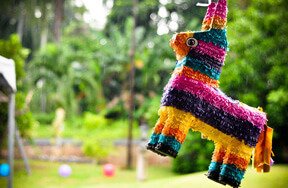"Heritage" is defined as the customs and traditions that are handed down from generation to generation of families and society. A person with Latino heritage is a descendant of a family from Mexico, Central America or South America. Peeps who are Hispanic are from a country where Spanish is spoken. In honor of Hispanic Heritage month, (which is celebrated from September 15th to October 15th), let's check out some of their traditions.
Hispanic Holidays
Cinco de Mayo
Cinco de Mayo is a proud day for Mexicans who celebrate the victory over the French at the battle of Pueblo on May 5, 1862. The French army was better armed and three times larger but the Mexican army still defeated them. Now every May 5th there are parades, music and lots of celebrating!

Mexican Independence Day
Every year on September 16th, the people of Mexico celebrate the day that they gained independence as a country. September 16th, 1810 marks the day when Mexican priest, Miguel Hidalgo y Costilla, called for the arrest of all Spanish settlers living in the town of Delores. He sparked a revolution that lasted over 11 years. But, by 1821, Mexico managed to claim its independence from Spain.
Puerto Rican Emancipation Day
Emancipation is when slaves were set free. Puerto Ricans celebrate Emancipation Day on March 22nd.
Hispanic Traditions and Culture
- Piñata: A decorated container filled with candy and toys is suspended in the air to be broken by blindfolded kids with sticks. Piñata's are used as part of Christmas and birthday celebrations in certain Latin-American countries. Find out how you can make your own piñata right here!
- Aztecs: These peeps are the native people of central Mexico whose civilization was at its height at the time of the Spanish conquest in the early 16th century.
- Quinceañera: The Quinceañera is the Latina coming-of-age celebration on a girl's 15th birthday. The word "quinceañera" comes from the Spanish words "quince" for 15 and "años" for years.
- El Chupacabra: El Chupacabra is a mythological creature whose name translated into English means "the goat-sucker," because that's exactly what it does. El Chupacabra made its first appearance in the farmlands of Puerto Rico where it left tons of goats dead. All of the goats had been left fully intact, but were drained of all their blood. Scary.
To check out more Hispanic culture and traditions, click here.
Related Stories:

































